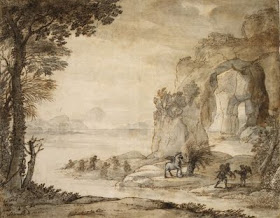Claude Lorrain, Perseus and the Discovery of Coral, c1671
(preparatory drawing for the Holkham Hall painting,
Metropolitan Museum of Art)
Metropolitan Museum of Art)
In Helen Langdon's catalogue for last year's Salvator Rosa exhibition she refers in her notes on his painting Landscape with a Natural Arch and Waterfall to the art history of a specific landform, the rocky arch. These were painted more frequently after 1626, when an ancient Roman landscape painting with a rocky arch was discovered in a nymphaeum near the Barberini palace. It was a favourite motif of Rosa's - either inland, as in the Detroit Finding of Moses, or by the sea, as in the Doria Pamphilj's Coastal Scene. In the Palazzo Pitti's Landscape with a Bridge the form of the rocky arch is echoed below by the arches of a crumbling bridge. Peering at small online images of picturesque landscapes, as I have just been doing, it is sometimes hard to distinguish ruined architecture from natural rock formations. Both feature in the work of Northern artists working in Italy in the seventeenth century, like Paul Bril and Jan Breughel I. Rosa was probably influenced by his fellow Neapolitan, Filippo Napoletano, who included the rocky arch in his frescoes for the Palazzo Rospigliosi Pallavicini, and by Claude Lorrain who 'worked numerous variations on it.' It would be fascinating to write a proper history of rock arches in art, covering these imaginary scenes and later works where artists sought to paint or photgraph real examples, like the cliffs at Etretat. We have recently had cultural histories of mountains, forests etc. and now I think it is time to focus on particular geographical features...
Gustave Courbet, La falaise d'Étretat après l'orage, 1870
Source: Wikimedia Commons
Source: Wikimedia Commons


Could it have something to do with the rock arch on Malta? Could that have started it? Actually ... how common are these geologic landforms? I don't have any data (yet).
ReplyDeletehttp://www.flickr.com/photos/benandabby/3345345950/
No .... that looks really different ...
A wonderful idea: there also are splendid Victorian photographs of such features as cliffs.
ReplyDeleteThis is an excellent blog. Please keep up the good work.
TD